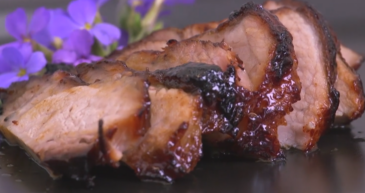Grilled Glazed Pork Roast Recipe: A Mouthwatering Masterpiece
Get ready to ignite your taste buds and impress your guests with our Grilled Glazed Pork Roast recipe. This succulent and flavor-packed dish combines the tenderness of a perfectly grilled pork roast with a luscious glaze that adds a sweet and savory twist. Grilling the roast infuses it with a smoky essence, while the glaze caramelizes to create a delectable crust.
Whether you’re hosting a summer barbecue or simply craving a show-stopping meal, this recipe will take center stage and leave everyone asking for seconds.
Ingredients:
- 1 (3-4 pound) boneless pork loin roast
- 1/4 cup Dijon mustard
- 2 tablespoons brown sugar
- 2 tablespoons honey
- 2 tablespoons soy sauce
- 2 cloves garlic, minced
- 1 teaspoon dried thyme
- 1 teaspoon paprika
- 1/2 teaspoon salt
- 1/2 teaspoon black pepper
Instructions:
Preparing the Pork Roast
Start by preparing your pork roast. If needed, trim any excess fat from the roast, leaving a thin layer for added flavor and moisture. Pat the roast dry with paper towels to ensure proper seasoning and glaze adherence.
Creating the Glaze
In a small bowl, whisk together the Dijon mustard, brown sugar, honey, soy sauce, minced garlic, dried thyme, paprika, salt, and black pepper. This glaze will be the star of the dish, providing a tantalizing balance of sweetness and tangy flavors.
Marinating the Pork Roast
Place the pork roast in a large resealable plastic bag or a shallow dish. Pour the glaze mixture over the roast, ensuring that it is evenly coated on all sides. Massage the glaze into the meat, allowing it to penetrate and infuse its flavors. Marinate the pork roast in the refrigerator for at least 2 hours, or overnight for maximum flavor development.
Preheating the Grill
Preheat your grill to medium-high heat, aiming for a temperature of around 350-400°F (175-200°C). Ensure that the grill grates are clean and well-oiled to prevent sticking.
Grilling the Pork Roast
Remove the marinated pork roast from the refrigerator and place it on the preheated grill. Close the lid and grill for approximately 15-20 minutes per pound, or until the internal temperature reaches 145°F (63°C). Use a meat thermometer inserted into the thickest part of the roast to check for doneness.
Glazing the Pork Roast
During the last 10 minutes of grilling, baste the pork roast with the remaining glaze. Brush the glaze generously over the entire surface of the roast, allowing it to caramelize and create a beautiful crust. Be sure to reserve some glaze for serving.
Resting and Serving
Once the pork roast reaches the desired temperature, remove it from the grill and transfer it to a cutting board. Tent the roast loosely with aluminum foil and allow it to rest for about 10 minutes. This resting period allows the juices to redistribute, resulting in a tender and juicy roast. Slice the pork roast into thin slices and serve it with the reserved glaze on the side.
Conclusion
Elevate your grilling game with our Grilled Glazed Pork Roast recipe, a tantalizing combination of succulent meat and a delectable sweet and savory glaze. The tender and smoky flavors of the grilled pork, enhanced by the caramelized glaze, will make every bite worth the effort and reward your senses.
HISTORY
The History of Fire-Cooked Pork: From Ancient Origins to Culinary Delight
Fire-cooked pork is a culinary tradition that spans centuries and cultures, showcasing the primal method of using fire to transform raw pork into a flavorful and tender delight. The history of fire-cooked pork is deeply rooted in human civilization, where the discovery of fire and the utilization of pork as a food source have played significant roles. Let’s explore the rich history of fire-cooked pork and its cultural significance.
Ancient Beginnings:
The practice of cooking pork over an open flame dates back thousands of years. The origins can be traced to the early human civilizations that discovered the benefits of controlled fire. With the ability to generate heat and cook food, humans discovered that cooking pork over an open fire not only made it safer to consume but also enhanced its flavor and texture.
Civilizations across the globe, from the ancient Greeks and Romans to the indigenous cultures of the Americas and Asia, embraced the art of fire-cooked pork. Pork became a staple protein source due to the domestication of pigs and their abundance in many regions.
Cultural Significance:
Fire-cooked pork holds cultural significance in various societies. In many cultures, including the European and American traditions, pork holds symbolic and festive connotations. Roasting a whole pig over an open fire became a centerpiece of celebratory gatherings, weddings, and religious festivals, symbolizing abundance, hospitality, and community.
For instance, the pig roast or hog roast is a cherished tradition in many European countries, such as Spain with its “Cochinillo Asado” and Portugal with its “Leitão Assado.” In the United States, pig roasts are popular in Southern barbecue traditions, Hawaiian luaus, and other festive occasions.
Cooking Techniques:
Throughout history, different cultures developed various cooking techniques for fire-cooked pork, showcasing regional flavors and traditions.
One popular method is spit-roasting, where the whole pig is skewered and rotated slowly over an open flame. This technique ensures even cooking and imparts a smoky flavor. The process requires patience and skill, as the pig must be constantly monitored and basted to retain moisture.
Another method is pit-roasting, where the pig is cooked in a large pit dug into the ground. The pig is seasoned, wrapped in banana leaves or other materials, and placed over hot coals or stones. The pit is then covered, allowing the pig to slow-cook in its own juices, resulting in tender and succulent meat.
In addition to whole-pig roasts, fire-cooked pork encompasses a range of dishes and preparations. Grilled pork chops, skewered pork kebabs, char siu (Chinese barbecue pork), and smoked pork ribs are just a few examples of fire-cooked pork dishes enjoyed worldwide.
Modern Adaptations:
While the traditional methods of fire-cooking pork still hold strong cultural significance, modern culinary techniques and equipment have also influenced the preparation of fire-cooked pork. Today, backyard barbecues, grilling competitions, and professional kitchens utilize advanced grills, smokers, and rotisseries to achieve desired flavors and textures.
Furthermore, the use of marinades, dry rubs, and sauces has become popular, allowing for customization and flavor experimentation. Different wood chips and charcoal varieties are used to impart distinct smoky flavors, adding another layer of complexity to fire-cooked pork.
The history of fire-cooked pork is deeply intertwined with human civilization, showcasing our mastery of fire and our appreciation for the rich flavors and textures that can be achieved through the cooking process. From ancient cultures to modern-day gatherings, fire-cooked pork remains a culinary delight and a symbol of community, celebration, and cultural heritage.

